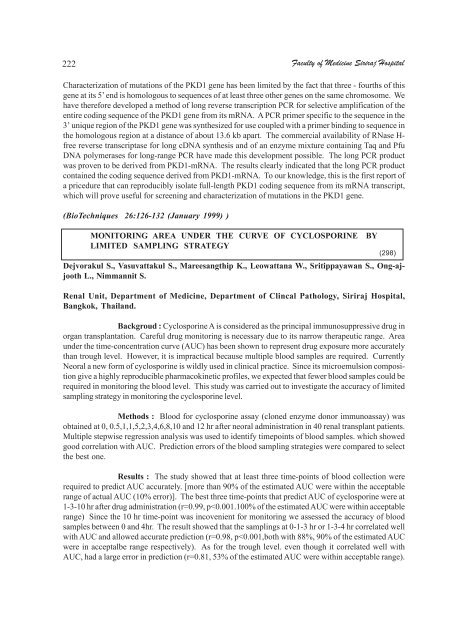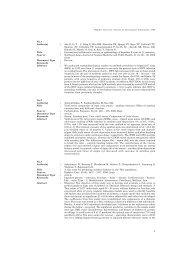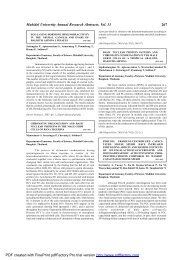THE OSTIA VENAE HEPATICAE AND THE RETHROHEPATIC ...
THE OSTIA VENAE HEPATICAE AND THE RETHROHEPATIC ...
THE OSTIA VENAE HEPATICAE AND THE RETHROHEPATIC ...
You also want an ePaper? Increase the reach of your titles
YUMPU automatically turns print PDFs into web optimized ePapers that Google loves.
222<br />
Characterization of mutations of the PKD1 gene has been limited by the fact that three - fourths of this<br />
gene at its 5’ end is homologous to sequences of at least three other genes on the same chromosome. We<br />
have therefore developed a method of long reverse transcription PCR for selective amplification of the<br />
entire coding sequence of the PKD1 gene from its mRNA. A PCR primer specific to the sequence in the<br />
3’ unique region of the PKD1 gene was synthesized for use coupled with a primer binding to sequence in<br />
the homologous region at a distance of about 13.6 kb apart. The commercial availability of RNase Hfree<br />
reverse transcriptase for long cDNA synthesis and of an enzyme mixture containing Taq and Pfu<br />
DNA polymerases for long-range PCR have made this development possible. The long PCR product<br />
was proven to be derived from PKD1-mRNA. The results clearly indicated that the long PCR product<br />
contained the coding sequence derived from PKD1-mRNA. To our knowledge, this is the first report of<br />
a pricedure that can reproducibly isolate full-length PKD1 coding sequence from its mRNA transcript,<br />
which will prove useful for screening and characterization of mutations in the PKD1 gene.<br />
(BioTechniques 26:126-132 (January 1999) )<br />
Faculty of Medicine Siriraj Hospital<br />
MONITORING AREA UNDER <strong>THE</strong> CURVE OF CYCLOSPORINE BY<br />
LIMITED SAMPLING STRATEGY<br />
(298)<br />
Dejvorakul S., Vasuvattakul S., Mareesangthip K., Leowattana W., Sritippayawan S., Ong-ajjooth<br />
L., Nimmannit S.<br />
Renal Unit, Department of Medicine, Department of Clincal Pathology, Siriraj Hospital,<br />
Bangkok, Thailand.<br />
Backgroud : Cyclosporine A is considered as the principal immunosuppressive drug in<br />
organ transplantation. Careful drug monitoring is necessary due to its narrow therapeutic range. Area<br />
under the time-concentration curve (AUC) has been shown to represent drug exposure more accurately<br />
than trough level. However, it is impractical because multiple blood samples are required. Currently<br />
Neoral a new form of cyclosporine is wildly used in clinical practice. Since its microemulsion composition<br />
give a highly reproducible pharmacokinetic profiles, we expected that fewer blood samples could be<br />
required in monitoring the blood level. This study was carried out to investigate the accuracy of limited<br />
sampling strategy in monitoring the cyclosporine level.<br />
Methods : Blood for cyclosporine assay (cloned enzyme donor immunoassay) was<br />
obtained at 0, 0.5,1,1,5,2,3,4,6,8,10 and 12 hr after neoral administration in 40 renal transplant patients.<br />
Multiple stepwise regression analysis was used to identify timepoints of blood samples. which showed<br />
good correlation with AUC. Prediction errors of the blood sampling strategies were compared to select<br />
the best one.<br />
Results : The study showed that at least three time-points of blood collection were<br />
required to predict AUC accurately. [more than 90% of the estimated AUC were within the acceptable<br />
range of actual AUC (10% error)]. The best three time-points that predict AUC of cyclosporine were at<br />
1-3-10 hr after drug administration (r=0.99, p

















